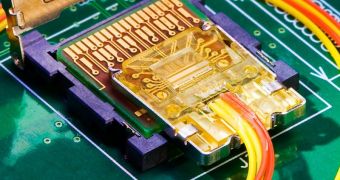Considered as one of the major breakthroughs in chip manufacturing, silicon photonics is far away from becoming a reality, an IBM researcher just affirming that at least 10 years have to pass until this technology will become a reality.
Speaking during the SPIE Photonics West 2011 conference, Bert-Jan Offrein, manager of photonics at IBM's Zurich Research Lab said that logic, memory and optical interconnects are on the horizon, but won't be available for at least 10 years from now.
According to the IBM researcher, advancements is this field are driven by the improvements brought to supercomputers, as their performance is increasing 10 fold every four years, requiring new technologies that deliver exponential increases in communications at all levels of the system.
However, before silicon photonics will find its way inside processors, the technology could be used to form shorter links inside computing systems, similar to what Intel has planed for its Light Peak technology.
As EETimes reports, the main challenge in developing 3-D chips with integrated optics is to bundle together the optics and the processing cores on the same package.
A solution to this problem would be to integrate the silicon photonics unit in a separate package, at the back end of production.
Whatever the answer it may be, silicon photonics is becoming increasingly popular among chip manufacturers, as both IBM and Intel try to find a way to incorporate the technology into their CPUs.
To speed up its plans, Intel has recently announced that it will co-fund a research and production centre at the University of Washington that will specialize in optical interconnects.
IBM is also experimenting with the technology and even managed to build a micro-miniaturized Mach-Zenhder electro-optic modulator in 2007.
Silicon photonics promises to replace the electrical connections found inside today's processor with faster and more energy efficient optical connections, enabling CPU manufacturers to keep up with Moore's Law.

 14 DAY TRIAL //
14 DAY TRIAL //